1. Melmed S, Casanueva FF, Hoffman AR, Kleinberg DL, Montori VM, Schlechte JA, et al. Diagnosis and treatment of hyperprolactinemia: an Endocrine Society clinical practice guideline. J Clin Endocrinol Metab. 2011; 96(2):273–288. PMID:
21296991.


2. Casanueva FF, Molitch ME, Schlechte JA, Abs R, Bonert V, Bronstein MD, et al. Guidelines of the Pituitary Society for the diagnosis and management of prolactinomas. Clin Endocrinol (Oxf). 2006; 65(2):265–273. PMID:
16886971.


3. Gillam MP, Molitch ME, Lombardi G, Colao A. Advances in the treatment of prolactinomas. Endocr Rev. 2006; 27(5):485–534. PMID:
16705142.


4. Dekkers OM, Lagro J, Burman P, Jørgensen JO, Romijn JA, Pereira AM. Recurrence of hyperprolactinemia after withdrawal of dopamine agonists: systematic review and meta-analysis. J Clin Endocrinol Metab. 2010; 95(1):43–51. PMID:
19880787.


5. Molitch ME. Medical treatment of prolactinomas. Endocrinol Metab Clin North Am. 1999; 28(1):143–169. PMID:
10207689.


6. Zanettini R, Antonini A, Gatto G, Gentile R, Tesei S, Pezzoli G. Valvular heart disease and the use of dopamine agonists for Parkinson's disease. N Engl J Med. 2007; 356(1):39–46. PMID:
17202454.


7. Schade R, Andersohn F, Suissa S, Haverkamp W, Garbe E. Dopamine agonists and the risk of cardiac-valve regurgitation. N Engl J Med. 2007; 356(1):29–38. PMID:
17202453.


8. Biswas M, Smith J, Jadon D, McEwan P, Rees DA, Evans LM, et al. Long-term remission following withdrawal of dopamine agonist therapy in subjects with microprolactinomas. Clin Endocrinol (Oxf). 2005; 63(1):26–31. PMID:
15963057.


9. Cannavò S, Curtò L, Squadrito S, Almoto B, Vieni A, Trimarchi F. Cabergoline: a first-choice treatment in patients with previously untreated prolactin-secreting pituitary adenoma. J Endocrinol Invest. 1999; 22(5):354–359. PMID:
10401709.

10. Kharlip J, Salvatori R, Yenokyan G, Wand GS. Recurrence of hyperprolactinemia after withdrawal of long-term cabergoline therapy. J Clin Endocrinol Metab. 2009; 94(7):2428–2436. PMID:
19336508.



11. Amar AP, Couldwell WT, Chen JC, Weiss MH. Predictive value of serum prolactin levels measured immediately after transsphenoidal surgery. J Neurosurg. 2002; 97(2):307–314. PMID:
12186458.


12. Kreutzer J, Buslei R, Wallaschofski H, Hofmann B, Nimsky C, Fahlbusch R, et al. Operative treatment of prolactinomas: indications and results in a current consecutive series of 212 patients. Eur J Endocrinol. 2008; 158(1):11–18. PMID:
18166812.


13. Turner HE, Adams CB, Wass JA. Trans-sphenoidal surgery for microprolactinoma: an acceptable alternative to dopamine agonists? Eur J Endocrinol. 1999; 140(1):43–47. PMID:
10037250.


14. Buchfelder M, Schlaffer S. Surgical treatment of pituitary tumours. Best Pract Res Clin Endocrinol Metab. 2009; 23(5):677–692. PMID:
19945031.


15. Couldwell WT. Transsphenoidal and transcranial surgery for pituitary adenomas. J Neurooncol. 2004; 69(1-3):237–256. PMID:
15527094.


16. Qu X, Wang M, Wang G, Han T, Mou C, Han L, et al. Surgical outcomes and prognostic factors of transsphenoidal surgery for prolactinoma in men: a single-center experience with 87 consecutive cases. Eur J Endocrinol. 2011; 164(4):499–504. PMID:
21252173.


17. Jan M, Dufour H, Brue T, Jaquet P. Prolactinoma surgery. Ann Endocrinol (Paris). 2007; 68(2-3):118–119. PMID:
17512893.


18. Woodworth GF, Patel KS, Shin B, Burkhardt JK, Tsiouris AJ, McCoul ED, et al. Surgical outcomes using a medial-to-lateral endonasal endoscopic approach to pituitary adenomas invading the cavernous sinus. J Neurosurg. 2014; 120(5):1086–1094. PMID:
24527820.



19. Salazar-López-Ortiz CG, Hernández-Bueno JA, González-Bárcena D, López-Gamboa M, Ortiz-Plata A, Porias-Cuéllar HL, et al. Clinical practice guideline for the diagnosis and treatment of hyperprolactinemia. Ginecol Obstet Mex. 2014; 82(2):123–142. PMID:
24779268.

20. Halperin Rabinovich I, Cámara Gómez R, García Mouriz M, Ollero García-Agulló D. Grupo de Trabajo de Neuroendocrinología de la SEEN. Clinical guidelines for diagnosis and treatment of prolactinoma and hyperprolactinemia. Endocrinol Nutr. 2013; 60(6):308–319. PMID:
23477758.


21. Ma Q, Su J, Li Y, Wang J, Long W, Luo M, et al. The chance of permanent cure for micro- and macroprolactinomas, medication or surgery? a systematic review and meta-analysis. Front Endocrinol (Lausanne). 2018; 9:636. PMID:
30410470.



22. Donegan D, Atkinson JL, Jentoft M, Natt N, Nippoldt TB, Erickson B, et al. Surgical outcomes of prolactinomas in recent era: results of a heterogenous group. Endocr Pract. 2017; 23(1):37–45. PMID:
27682355.


23. Primeau V, Raftopoulos C, Maiter D. Outcomes of transsphenoidal surgery in prolactinomas: improvement of hormonal control in dopamine agonist-resistant patients. Eur J Endocrinol. 2012; 166(5):779–786. PMID:
22301915.


24. Klibanski A. Dopamine agonist therapy in prolactinomas: when can treatment be discontinued? J Clin Endocrinol Metab. 2009; 94(7):2247–2249. PMID:
19584197.


25. Dallapiazza RF, Jane JA Jr. Outcomes of endoscopic transsphenoidal pituitary surgery. Endocrinol Metab Clin North Am. 2015; 44(1):105–115. PMID:
25732647.


26. Dehdashti AR, Ganna A, Karabatsou K, Gentili F. Pure endoscopic endonasal approach for pituitary adenomas: early surgical results in 200 patients and comparison with previous microsurgical series. Neurosurgery. 2008; 62(5):1006–1015. PMID:
18580798.

27. Cappabianca P, Cavallo LM, Colao A, de Divitiis E. Surgical complications associated with the endoscopic endonasal transsphenoidal approach for pituitary adenomas. J Neurosurg. 2002; 97(2):293–298. PMID:
12186456.


28. Pascal-Vigneron V, Weryha G, Bosc M, Leclere J. Hyperprolactinemic amenorrhea:treatment with cabergoline versus bromocriptine. Results of a national multicenter randomized double-blind study. Presse Med. 1995; 24(16):753–757. PMID:
7784413.

29. Maiter D. Management of dopamine agonist-resistant prolactinoma. Neuroendocrinology. 2019; 109(1):42–50. PMID:
30481756.


30. Vroonen L, Jaffrain-Rea ML, Petrossians P, Tamagno G, Chanson P, Vilar L, et al. Prolactinomas resistant to standard doses of cabergoline: a multicenter study of 92 patients. Eur J Endocrinol. 2012; 167(5):651–662. PMID:
22918301.


31. Jethwa PR, Patel TD, Hajart AF, Eloy JA, Couldwell WT, Liu JK. Cost-effectiveness analysis of microscopic and endoscopic transsphenoidal surgery versus medical therapy in the management of microprolactinoma in the United States. World Neurosurg. 2016; 87:65–76. PMID:
26548828.

32. Zygourakis CC, Imber BS, Chen R, Han SJ, Blevins L, Molinaro A, et al. Cost-effectiveness analysis of surgical versus medical treatment of prolactinomas. J Neurol Surg B Skull Base. 2017; 78(2):125–131. PMID:
28321375.

33. Duan L, Yan H, Huang M, Zhang Y, Gu F. An economic analysis of bromocriptine versus trans-sphenoidal surgery for the treatment of prolactinoma. J Craniofac Surg. 2017; 28(4):1046–1051. PMID:
28145933.


34. Song YJ, Chen MT, Lian W, Xing B, Yao Y, Feng M, et al. Surgical treatment for male prolactinoma: a retrospective study of 184 cases. Medicine (Baltimore). 2017; 96(2):e5833. PMID:
28079813.
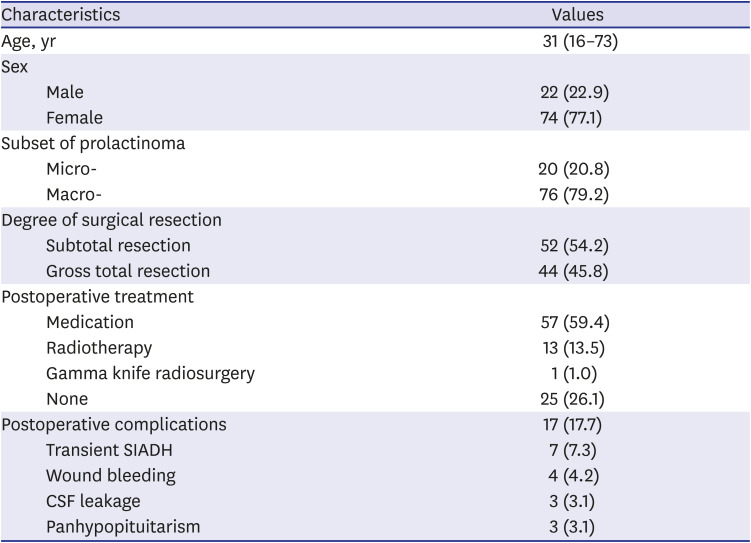


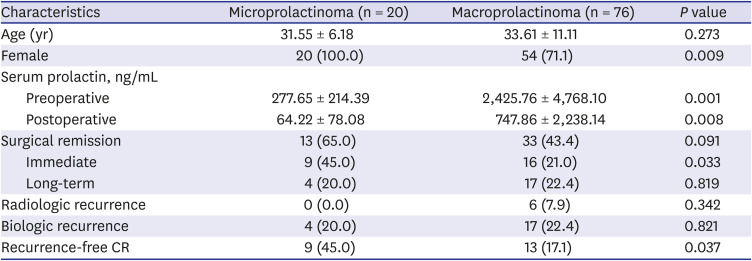





 PDF
PDF Citation
Citation Print
Print



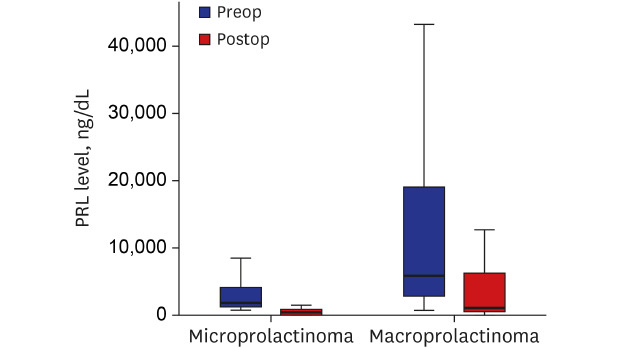
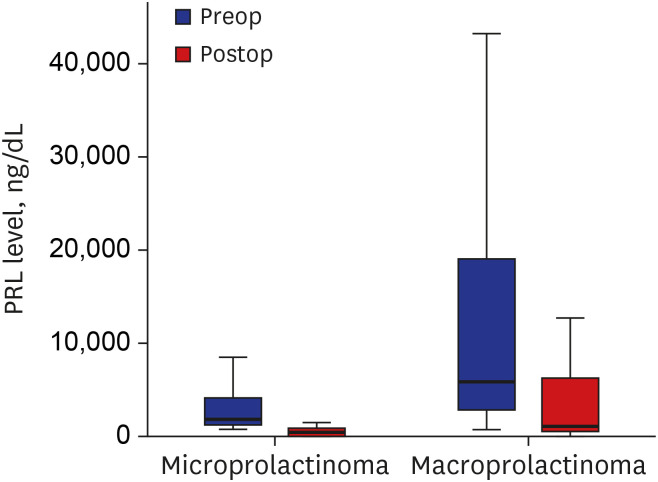
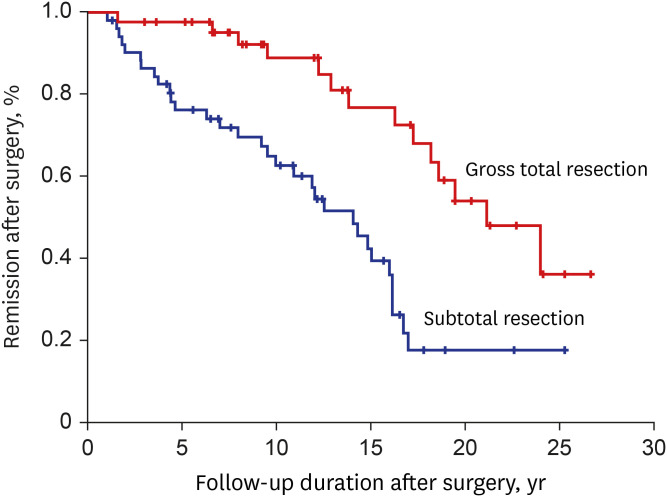
 XML Download
XML Download